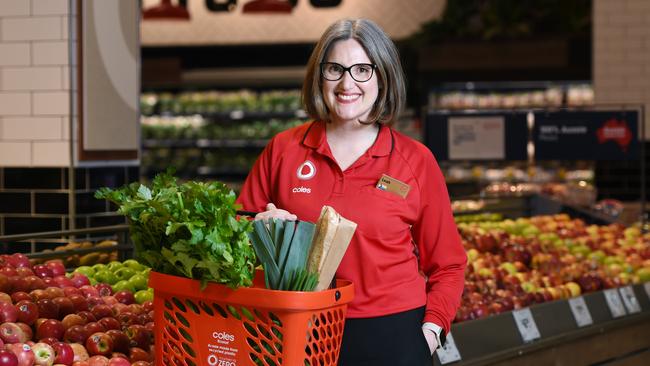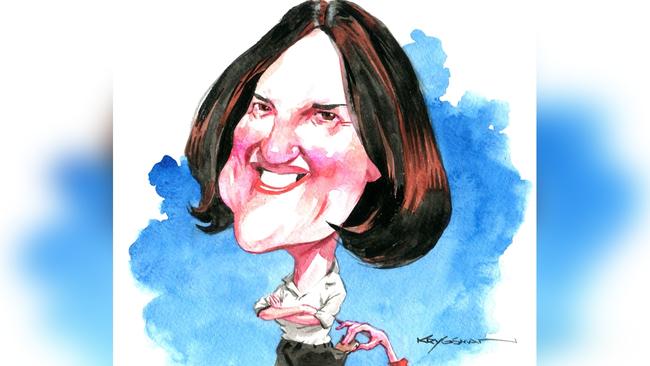
This month the ASX 200 has fallen by more than 4 per cent, bringing the year to date rise just over 1 per cent, as corporate reality hits home.
Friday’s report from Wesfarmers was a standout, showing the expected retail slowdown in earnings and post-Covid staff safety issues at Bunnings, but also the benefits of continued investment through the cycle.
This was also evident in the contrasting retail results from Woolworths and Coles, with the latter’s new boss, Leah Weckert, facing increased costs for her logistics (Witron) and online facilitator (Ocado) on top of the general inflationary concerns.
It was also notable Coles called out increased shoplifting. While it’s an issue across the board it didn’t hurt the results reported by others, perhaps due to better system controls.
Weckert was CFO before replacing Stephen Cain earlier this year. He timed his run to perfection by announcing the big warehouse and online logistics deals before leaving it to his successor for the final execution – and, it seems, cost blowouts.
A new earnings line will be delivered by Wesfarmers next year, with the lithium project tipped to report annualised earnings of $300m in 2024 and to grow to $670m in the 2026 financial year, on estimates from UBS analyst Shaun Cousins.
Wesfarmers reported a pleasing increase in returns to 31.4 per cent from 29.4 a year ago, despite a fall in Bunnings’ returns from 77.2 per cent to 65.4 as the retailer normalised inventory from Covid levels.

The market is now expecting earnings across the market to grow by 1.8 per cent for the 2023 year against the 2.5 per cent rise tipped before the results, and now expects earnings to fall 5.4 per cent in 2024, down from negative 0.8 per cent ahead of the season.
While optimists say the results were better than expected they weren’t great and provide more evidence of a loss of momentum in the economy.
Figures supplied by AMP’s Shane Oliver show there were upside surprises in 41 per cent of results, against the normal trend of 43 per cent.
This explains why stock prices rose after just half the results, against the more normal 54 per cent.
Some 46 per cent of companies reported an increase in dividends, up from 43 per cent in February at the half-year results, but down on the 58 per cent normally reported.
On a final note, amid continued debate about the market’s undue obsession with ESG, Wesfarmers Michael Chaney put it into context in his annual report, saying “we don’t see any conflict between looking after shareholders and other stakeholders because you can’t achieve the former without doing the latter”.
Wesfarmers likes to report satisfactory returns knowing it must look after staff and customers, treat suppliers fairly, protect the environment and support communities.
It’s that simple.
Carbon confusion
A casual review of the press suggest there is no shortage of potential carbon exchanges as the market looks for carbon solutions, which raises the question of just how many exchanges are really needed.
Carbon Growth Partners’ Rich Gilmore figures the answer is somewhere between zero and one, arguing that the most important task is to scale up high-quality project supply.
Maybe a better-functioning market would encourage more supply, but project developers remain to be convinced.
They also report many offset buyers are looking for specific project rather than an off-the-shelf commodity deal.
In October, the Clean Energy Regulator will provide an update to a project launched over two years ago under the previous government, to establish a carbon trading platform. It attracted proposals from the ASX and Xpansiv, among others. CBA is backing Xpansiv while NAB is involved in another project.
It seems the CER model will be to establish a registration body which will facilitate a carbon exchange rather than establishing a new trading platform.
CER said: “The project aims to facilitate the emergence of an exchange trading market for Australian carbon credit units (ACCUs), connected to a new and improved unit register. The new unit register is anticipated to be launched by the end of 2023.”
This comes as former ACCC boss Rod Sims, wearing his Super Power Institute hat, told a function in Perth this week that the carbon debate was wrongly focused on emissions reduction when it should be looking at the extraordinary market Australia has at its feet in developing net zero opportunities. These included renewables, led by solar and wind and so called future-facing commodities. He is right.
By way of example, UBS analyst Shaun Cousins is forecasting earnings from Wesfarmers’ Mt Holland lithium project to grow from $150m in the first half of next calendar year to $235m in 2025 and $666m in 2026.
As to the plethora of carbon markets, the market will sort it out and the best one should survive.
Competition concerns
Next weekend, the trade practices mafia will gather in Melbourne for the annual Law Council conference on competition policy issues.
In the wake of this week’s two-year review of competition policy, the lawyers and economists involved will be hoping Treasurer Jim Chalmers’ promise of a staged “iterative” review will mean proposed merger law changes will come sooner rather than later.
They were first proposed by review panel member Rod Sims two years ago, and affirmed by present ACCC boss Gina Cass-Gottlieb in March this year.
The mafia is universally opposed to proposed changes to reverse the merger onus of proof in informal clearances, where the parties would have to convince the ACCC the merger doesn’t substantially lessen competition, as in the present authorisation tests. For now it’s the ACCC that must prove the lessening in competition.
As an aside, the ANZ formally lodged its appeal to the recent Suncorp rejection on Friday.
Quay Law Partners’ Dave Poddar and Clayton Utz’s Michael Corrigan have raised concern over ACCC’s increased powers.
This is particularly so as proposed thresholds for merger notification are for deals above a $400m combined turnover or $35m deal value – deal metrics which wouldn’t get most investment bankers and competition lawyers out of bed in the morning.
Poddar notes: “The authorisation merger test is hard to satisfy, particularly in concentrated industries where the ACCC must be satisfied that the merger does not substantially lessen competition or that public benefits outweigh any substantial lessening of competition.”
Next week’s conference will feature a paper from Israeli law Professor Michal Gal on mergers in small markets and a session from the new ACCC chief economist Lilla Csorgo.
Sessions in the conference include labour issues, which will cover the non-compete clauses Andrew Leigh wants banned, and how you do this without affecting the exemption to other industrial relations issues. There will also be one on merger authorisations and unfair contracts.




A solid Wesfarmers result rounds out a tough corporate reporting season, with earnings expectations downgraded 1.5 per cent in a weakening economy and cost increases amid continued inflation adding to the headwinds.